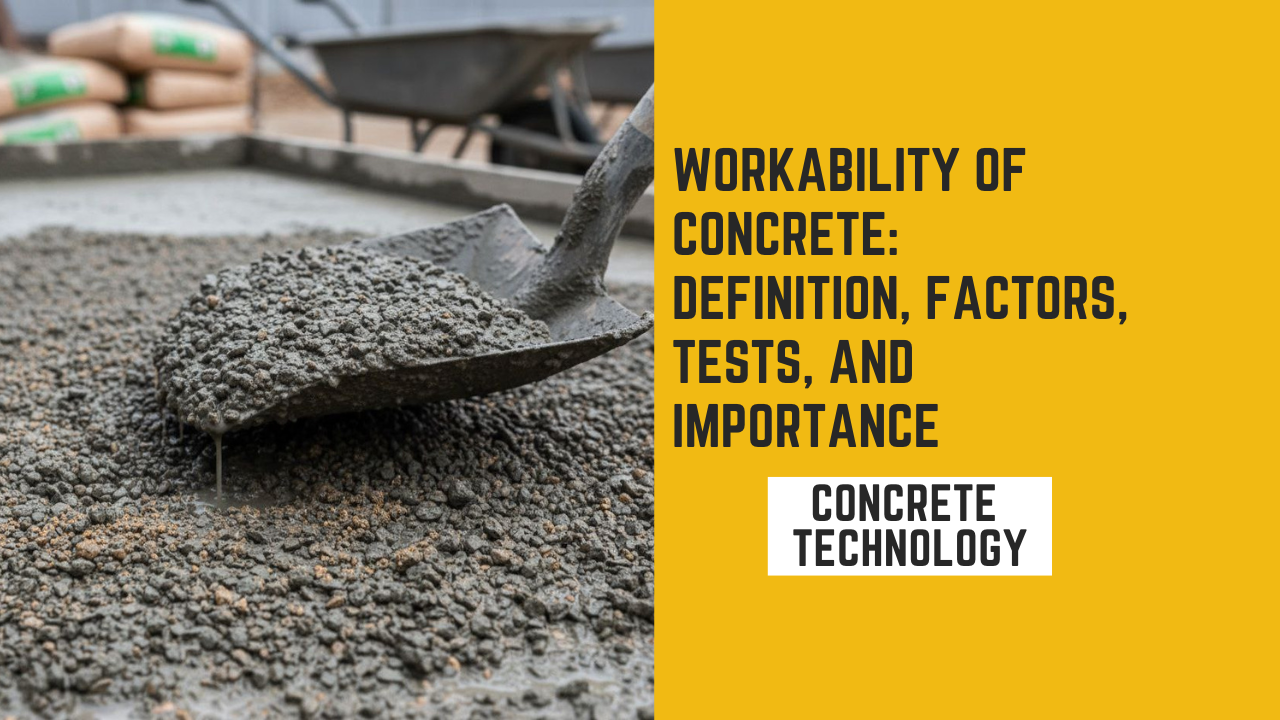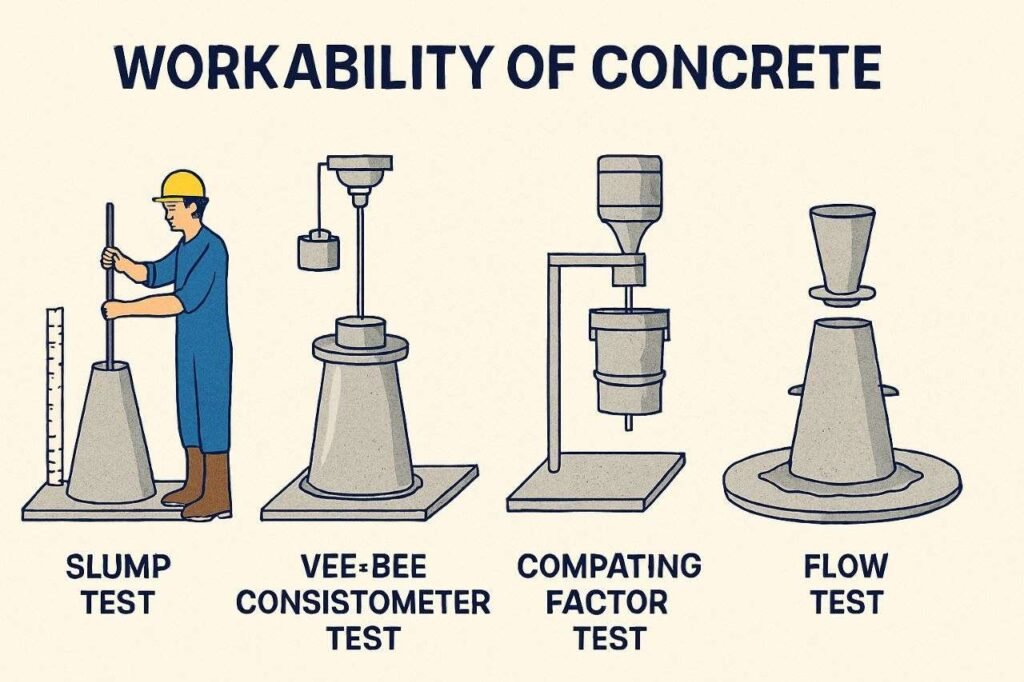Workability of concrete: Definition, factors, tests, and Importance |A Ultimate guide 2025

Concrete is one of the most widely used construction materials in the world, forming the backbone of modern infrastructure. While compressive strength often takes center stage in concrete design, workability is equally important. Workability of concrete determines how easily fresh concrete can be mixed, placed, compacted and finished without segregation or loss of homogeneity
if concrete is too stiff, it becomes difficult to handle and may not fill formwork properly. On the other hand, if it is too fluid, segregation and bleeding may occur, compromising strength and durability. Hence, striking the right balance of workability is crucial for both small-scale and large-scale projects
This article provides a complete guide to the workability of concrete, including its definition, factors affecting it, methods of measurement, practical considerations, and industry standards.
What is the workability of concrete?
The workability of concrete is the ease with which fresh concrete can be mixed, transported, placed, compacted, and finished to achieve a homogeneous and defect-free structure.
Key points:
- Too low workability of concrete leads to honeycombing, voids, and poor compaction
- Too high workability of concrete causes segregation, bleeding, and reduced durability.
- Right workability—depends on the type of construction, placement method, and reinforcement congestion
For example:
- Pavement concrete requires low workability because it is spread and compacted mechanically.
- Heavily reinforced beams or slabs require high workability to ensure concrete flows around bars.
Importance of workability of concrete
Workability is not just about handling concrete easily. It effects
1. Structural strength—poorly completed concrete reduces actual strength compacted to design strength
2. Durability—workable concrete ensures proper compaction, reducing permeability and increasing resistance to weathering
3. Construction speed—higher workability allows quicker placement, reducing labor costs.
4. Finish Quality—Smooth and defect-free surfaces depend on workable mixes.
5. Cost Efficiency – Optimizing workability reduces wastage of cement, water, and labor
Factors Affecting Workability of Concrete
Several factors influence the workability of concrete. These can broadly grouped as material factors and operational factors
1. Water cement
Increasing water content increases workability (up to a point).
Excess water reduces strength and durability by increasing the water-cement ratio.
2. Water-Cement Ratio (W/C)
Lower W/C—stiff and less workable concrete.
Higher W/C—more workable but weaker concrete.
Optimal W/C—balances strength and workability.
3. Aggregate Size and Shape
Rounded aggregates—more workable due to reduced friction.
Angular, flaky, or elongated aggregates reduce workability.
Larger aggregate size—less surface area → better workability (if grading is good).
4. Aggregate Grading
Well-graded aggregates improve workability by reducing voids.
Poor grading leads to harsh mixes requiring more cement paste.
5. Cement Content
Higher cement content increases paste volume → better lubrication → improved workability.
However, too much cement increases cost and shrinkage risk.
6. Use of Admixtures
Plasticizers and superplasticizers significantly improve workability without increasing water content.
Retarders improve workability over time (useful in hot weather concreting).
Air-entraining agents increase workability by creating tiny air bubbles.
7. Temperature and Weather Conditions
High temperature causes water evaporation, reducing workability.
Windy or dry weather accelerates setting, affecting handling.
8. Reinforcement Congestion
Heavily reinforced sections require higher workability to allow concrete flow.
For example, a thin slab with dense reinforcement requires a more fluid mix compared to a mass footing.

Methods of Measuring Workability
Several tests are used to measure workability. Choice of test depends on concrete type and site conditions.
1. Slump Test
- Most common test for normal concrete
- Measures vertical settlement (slump) of a cone of concrete.
- Standard slump cone: 300 mm height, 200 mm bottom dia, 100 mm top dia
- Methods of Measuring Workability.
Types of Slump
- True slump – vertical settlement (good)
- Shear slump – slipping along a plane (indicates poor cohesion)
- Collapse slump – too wet (overly workable).
Slump ranges (as per IS 1199:1959):
- Low workability: 25-75 mm (pavements, roads).
- Medium workability: 50-100 mm (beams, slabs, columns)
- High workability: 100-175 mm (heavily reinforced structures).
2. Compaction Factor Test
- Measures degree of compaction achieved under standard effort
- More accurate than slump test for low-workability concretes
- Ratio weight of partially compacted concrete to fully compacted concrete
3. Vee-Bee Consistometer Test
- Suitable for stiff concrete (low workability).
- Measures time taken for concrete to change shape under vibration.
- Expressed in Vee-Bee seconds.
4. Flow Table Test
- Used for highly workable concrete (self-compacting)
- Concrete spread diameter is measured after jolting
- Common for SCC (Self-Compacting)
5. Kelly Ball Test (U.S. practice)
- Portable field test, measures penetration depth of a steel ball into concrete
- Directly correlates with slump test values

Recommended Workability for Different Types of Construction
Different structures need different levels of workability.
| Type of Work | Recommended Slump (mm) |
|---|---|
| Mass concrete (foundations) | 25–75 |
| Reinforced foundations | 50–100 |
| Beams and slabs | 75–100 |
| Columns | 75–150 |
| Pavement concrete (vibrated) | 25–75 |
| Road concrete (hand compacted) | 75–125 |
| Pumped concrete | 100–150 |
Practical Example
Suppose we are casting an RCC slab 150 mm thick with dense reinforcement.
- Required workability = high (slump around 100–150 mm).
- The mix design gives a W/C ratio of 0.45 and a slump of 60 mm.
- To improve workability without adding water:
- Add superplasticizer—slump increases to 120 mm.
- Strength remains unaffected since the W/C ratio is unchanged.
This shows why admixtures are crucial in modern concreting.
Improving Workability of concrete in Practice
1. Use well-graded aggregates with minimal flaky particles
2. Add plasticizers instead of water to increase slump
3. Avoid over-mixing, which causes segregation
4. Use cooling measures (chilled water, ice) in hot weather.
5. Adjust slump according to placement method (manual vs. pump).
Challenges in Maintaining Workability on Site
- Transport delay: Concrete loses workability with time
- Hot weather concreting: Rapid evaporation reduces slump.
- Long pumping distances: Require higher initial workability.
- Over-ordering can cause segregation and bleeding.
Proper planning and use of admixtures help overcome these issues
Workability of concrete in Special Concretes
Self-Compacting Concrete (SCC)
- Extremely high workability
- No need for vibration—flows under its own weight.
- Workability measured by slump flow (not ordinary slump)
High-performance concrete (HPC)
- Requires high strength and durability with balanced workability.
- Superplasticizers play a key role
Lightweight Concrete
- Workability differs due to lower density aggregates.
- Requires higher paste content for adequate flow
Conclusion
The workability of concrete is a fundamental property that governs not only ease of construction but also the strength, durability, and long-term performance of structures. Properly designed workability ensures that fresh concrete can be handled, placed, and compacted without defects.
Engineers must carefully balance water-cement ratio, aggregate properties, admixtures, and site conditions to achieve the desired workability. With modern admixtures and advanced testing methods, maintaining optimum workability has become more practical and reliable than ever before.
In simple terms, strength makes concrete last, but workability makes construction possible.






